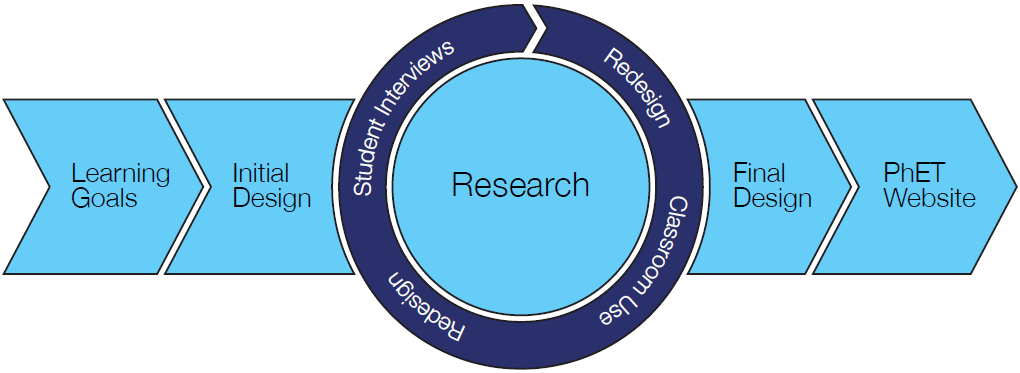Research and Design
Design

Our design process uses an inclusive approach, and involves partners and accessible technology users from across the United States and Canada. If you would like to get involved, email phethelp@colorado.edu for more information about ways you can join us.
Our partners include:
Research
As we design accessibility features, we also conduct research to investigate how students learn with these features. Our primary goal is to develop valid and generalizable approaches to increasing the accessibility of interactive STEM (science, technology, engineering, and mathematics) resources that can be used across PhET simulations, and to share these findings with the broader STEM education community.
2019
Brianna J. Tomlinson, Prakriti Kaini, E. Lynne Harden, Bruce N. Walker, & Emily B. Moore. A Multimodal Physics Simulation: Design and Evaluation with Diverse Learners. 34th CSUN Assistive Technology Conference. Anaheim, CA, USA. CSUN 2019 PDF Slides
Jesse Greenberg, Michael Kauzmann, Taliesin L. Smith, & Emily B. Moore. Using Scenery and the Parallel DOM to support accessible web applications. 34th CSUN Assistive Technology Conference. Anaheim, CA, USA. CSUN 2019 HTML Slides
2018
October 22 - 24, 2018 - Brianna Tomlinson, Prakriti Kaini, Siyan Zhou, Taliesin L. Smith, Emily B. Moore, and Bruce Walker. Design and evaluation of a multimodal science simulation. In Proceedings of the 20th International ACM SIGACCESS Conference on Computers & Accessibility Galway, Ireland. Assets 2018 Demonstration Poster
July 25-29 - Emily B. Moore and Taliesin L. Smith. Accessible interactive simulations for science education. AER International. Reno, NV, USA.
July 15-20 – Emily B. Moore, Taliesin L. Smith, and Jesse Greenberg. Keyboard and screen reader accessibility in complex interactive science simulations: Design challenges and elegant solutions. International Conference on Universal Access in Human-Computer Interaction. Las Vegas, NV, USA.
June 24, 2018 - Amanda McGarry and Ariel Paul. Using accessible simulations for more inclusive science inquiry. International Society for Technology in Education Conference & Expo. Chicago, IL, USA.
April 23-25 - Taliesin L. Smith, Jesse Greenberg, Sam Reid, Emily B. Moore. Parallel DOM architecture for interactive simulations. 15th International Cross-Disciplinary Conference on Web Accessibility. Lyon, France. W4A 2018 HTML Slides
March 19-23, 2018 - Brianna J. Tomlinson. Jared M. Batterman, Prakriti Kaini, Bruce N. Walker, and Emily B. Moore. Supporting simulation use for students with I/DD. 33rd CSUN Assistive Technology Conference. San Diego, CA, USA. CSUN 2018 PDF Slides
March 19-23, 2018 – Taliesin L. Smith, Jesse Greenberg, Michael Kauzmann, Michael Barlow and Emily B. Moore. Providing alternative input for complex interactive learning resources. 33rd CSUN Assistive Technology Conference. San Diego, CA, USA. CSUN 2018 HTML Slides
2017
November 16, 2017 - Taliesin Smith. Building accessibility and inclusion into interactive science simulations. Inclusive Design 24 (#ID24). Video Stream. ID24 2017 HTML Slides.
July 26-27, 2017 - Katherine K. Perkins & Emily B. Moore (2017). Increasing the accessibility of PhET Simulations for students with disabilities: Progress, challenges, and potential. Physics Education Research Conference. Cincinnati, OH, USA. PERC 2017 PDF Slides
February 27-March 4, 2017 – Taliesin L. Smith and Clayton Lewis, and Emily B. Moore. Description strategies to make an interactive science simulation accessible. 32nd CSUN Assistive Technology Conference. San Diego, CA. Presentation.
2016
November 14 & 15, 2016 – Taliesin L. Smith, Clayton Lewis, and Emily Moore. Inclusive interaction: Description strategies for a complex interactive science simulation. Teaching with Technology Community Conference. St. John's, Canada. Show 'n Tell Presentation.
October 24-26, 2016 – Taliesin L. Smith, Emily B. Moore, and Clayton Lewis. Demonstration: Screen reader support for a complex interactive science simulation. ACM SIGACCESS ASSETS Conference. Reno, NV. Poster PDF. Word.
July 19-22, 2016 – Taliesin L. Smith, Clayton Lewis, and Emily B. Moore. A balloon, a sweater, and a wall: Developing design strategies for accessible user experiences with a science simulation. International Conference on Universal Access in Human-Computer Interaction. Toronto, Canada. HTML. Slides.
July 19-22, 2016 – Emily B. Moore, Taliesin L. Smith, and Emily Randall. Exploring the relationships between implicit scaffolding and inclusive design in interactive science simulations. International Conference on Universal Access in Human-Computer Interaction. Toronto, Canada.
July 20-21, 2016 – Elise Morgan and Emily B. Moore. Exploring best practices in accessible design of interactive science simulations. Physics Education Research Conference. Sacramento, CA. Poster.
July 16-20, 2016 – Elise Morgan and Emily B. Moore. Exploring best practices in accessible design of interactive science simulations. AAPT Summer Meeting. Sacramento, CA.
June 1-3, 2016 – Emily B. Moore, Katherine Perkins, Jutta Treviranus. Ramping up accessibility in STEM: Inclusively designed simulations for diverse learners. NSF DRK-12 PI Meeting. Washington, DC. Poster.
May 17-23, 2016 – Emily B. Moore, Accessible PhET simulations for diverse learners. NSF STEM For All Video Showcase Virtual Showcase. Video.
May 7-12, 2016 – Emily Randall. Making science simulations accessible for students with vision impairments. ACM SIGCHI Conference on Human Factors in Computing Systems (CHI). San Jose, CA. Paper.
May 4-8, 2016 – Taliesin L. Smith. Access, action, agency: Inclusive design for the non-visual use of a highly interactive simulation. OCAD University Graduate Exhibition (GradEx). Toronto, Canada. Poster.
April 15, 2016 – Taliesin L. Smith. Access, action, agency: Inclusive design for the non-visual use of a highly interactive simulation. OCAD University. Toronto, Canada. Presentation.
February 23, 2016 – Emily B. Moore. Increasing the accessibility of PhET Simulations: Challenges, progress, and potential. Discipline-Based Education Research at the University of Colorado Boulder. Boulder, CO. Slides.
2015
November 9, 2015 – Kathy Perkins. Assistive technologies for learning: Broadening participation in STEM. (Panel Discussion including Jenna Gorlewicz, Ethan Danahy, Donna Lange, and Richard Ladner, Moderator: Rebecca Griffiths). Office of Science Technology and Policy (OSTP) 2015 Forum on Next Generation STEM Learning for All. Washington, D.C. Slides.
October 26-28, 2015 – Emily B. Moore & Clayton Lewis. Opportunity: Inclusive design for interactive simulations. ACM SIGACCESS International Conference on Computers and Accessibility (ASSETS), Lisbon, Portugal. Poster and Paper.
October 15, 2015 – Emily B. Moore. Emerging Innovations in Research and Practice. (Panel Discussion including Cathy Bodine and Jonathan Lazar, Moderator: Cyndi Rowland). 15th Annual Coleman Institute Conference on Cognitive Disability and Technology. Broomfield, CO.
October 14, 2015 – Emily B. Moore. Making interactive simulations accessible. College Consortium for Open Educational Resources (CCCOER) Webinar on OER and Accessibility. Webinar and slides.
August 2-7, 2015 – Emily B. Moore. Expanding beyond visual: Multimodal interactive visualizations for accessible STEM learning. Gordon Research Conference on Visualization in Science and Education. Lewiston, ME. Poster.
March 22-26, 2015 – Emily B. Moore. Designing accessible interactive chemistry simulations for all students – Including students with disabilities. American Chemical Society (ACS) Spring National Meeting. Denver, CO. Poster.
2019
Brianna J. Tomlinson, Prakriti Kaini, E. Lynne Harden, Bruce N. Walker, & Emily B. Moore. (2019). A Multimodal Physics Simulation: Design and Evaluation with Diverse Learners. The Journal on Technology & Persons with Disabilities, (in press).
2018
Brianna Tomlinson, Prakriti Kaini, Siyan Zhou, Taliesin L. Smith, Emily B. Moore, and Bruce Walker. (2018). Design and evaluation of a multimodal science simulation. In Proceedings of the 20th International ACM SIGACCESS Conference on Computers & Accessibility (pp. 438-440). Galway, Ireland. Assets 2018 Demonstration Poster
R. Michael Winters, Brianna J. Tomlinson, Bruce N. Walker, & Emily B. Moore. (Under Review). Sonic Information Design for Physics Education. Ergonomics in Design.
Emily B. Moore, Taliesin L. Smith, and, Jesse Greenberg (2018). Keyboard and screen reader accessibility in complex interactive science simulations: Design challenges and elegant solutions. In International Conference on Universal Access in Human-Computer Interaction. Las Vegas, USA. HCII 2018 Paper
Taliesin L. Smith, Jesse Greenberg, Sam Reid, Emily B. Moore (2018). Parallel DOM architecture for interactive simulations. In 15th International Cross-Disciplinary Conference on Web Accessibility. Lyon, France. W4A 2018 Paper
Brianna. J. Tomlinson, R. Michael Winter, Taliesin L. Smith, Bruce N. Walker, Emily, B. Moore (2018) Multimodal STEM simulations: Design, development, and evaluation. In CHI 2018 Workshop on: Emerging Opportunities in Inclusive Education for People with Visual Impairments. Montreal, QC, Canada. CHI 2018 Workshop Paper
Brianna. J. Tomlinson, Prakriti Kaini, Bruce N. Walker, Jared M. Batterman, & Emily, B. Moore (2018). Supporting simulation use for students with intellectual and developmental disabilities. The Journal on Technology & Persons with Disabilities, Volume 6(2018), 202–218. CSUN 2018 Paper
2017
Kathy K. Perkins and Emily B. Moore, Increasing the accessibility of PhET Simulations for students with disabilities: Progress, challenges, and potential, 2017 PERC Proceedings [Cincinnati, OH, July 26-27, 2017], edited by L. Ding, A. Traxler, and Y. Cao, doi:10.1119/perc.2017.pr.069. Download PERC 2017 Paper.
Taliesin L. Smith, Clayton Lewis, & Emily B. Moore (2017). Description strategies to make an interactive science simulation
accessible.The Journal on Technology and Persons with Disabilities, 590, 225-238.
Paper.
Note: Correction for link to
side-by-side demonstration noted in paper.
2016
Taliesin L. Smith, Clayton Lewis, and Emily B. Moore (2016). Demonstration: Screen reader support for a complex interactive science simulation. In Proceedings of the 18th International ACM SIGACCESS Conference on Computers and Accessibility (pp. 319–320). Reno, Nevada, USA: ACM New York, NY, USA. ASSETS 2016 Poster
Taliesin L. Smith and Emily B. Moore (2016). The PhET Interactive Simulations project: working to increase access to interactive STEM simulations [Part 2 of 2]. SNOW, Education, Access and You! Paper.
Emily B. Moore (2016). The PhET Interactive Simulations project: working to increase access to interactive STEM simulations [Part 1 of 2]. SNOW, Education, Access and You! Paper.
Taliesin L. Smith (2016). Access, action, & agency: Inclusive design for the non-visual use of a highly interactive science simulation. Masters in Inclusive Design. OCAD University, Toronto, Canada. Master Research Project.
Emily B. Moore, Taliesin L. Smith, & Emily Randall (2016, July). Exploring the relationship between implicit scaffolding and inclusive design in interactive science simulations. In International Conference on Universal Access in Human-Computer Interaction (pp. 112-123). Springer International Publishing. Paper.
Taliesin L. Smith, Clayton Lewis, & Emily B. Moore (2016, July). A balloon, a sweater, and a wall: developing design strategies for accessible user experiences with a science simulation. In International Conference on Universal Access in Human-Computer Interaction (pp. 147-158). Springer International Publishing. Paper.
Emily Randall (2016). Making science simulations accessible for students with vision impairments. Proceedings of the 34th Annual ACM Conference Extended Abstracts on Human Factors in Computing Systems (pp. 122-127). ACM. Paper.
Emily Randall (2016). Developing accessible physics simulations for students with vision impairments. Physics Education and Computer Science Undergraduate Honors Thesis. University of Colorado Boulder, Boulder, CO. Thesis.
Emily B. Moore (2016). ConfChem Conference on Interactive Visualizations for Chemistry Teaching and Learning: Accessibility for PhET Interactive Simulations Progress, Challenges, and Potential. Journal of Chemical Education. 93(6), 1160-1161. Paper..
Emily B. Moore (2016). Accessibility for PhET Interactive Simulations—progress, challenges, and potential. Spring 2015 ConfChem: Interactive Visualizations for Chemistry Teaching and Learning. Paper.
Emily B. Moore & Paul Grossman (2016). ConfChem conference on interactive visualizations for chemistry teaching and learning: The cutting edge — educational innovation, disability law, and civil rights. Journal of Chemical Education. 93(6), 1154-1155. Paper.
2015
Emily B. Moore & Clayton Lewis (2015, October). Opportunity: Inclusive design for interactive simulations. In Proceedings of the 17th International ACM SIGACCESS Conference on Computers & Accessibility (pp. 395-396). ACM. Paper.
Paul Grossman, Adapted by Emily B. Moore (2015). The cutting edge: educational innovation, disability law, and civil rights. Spring 2015 ConfChem: Interactive Visualizations for Chemistry Teaching and Learning Chemistry. Paper.







